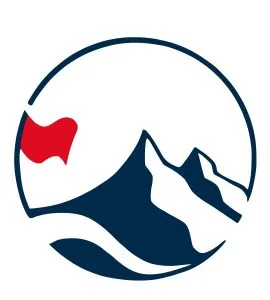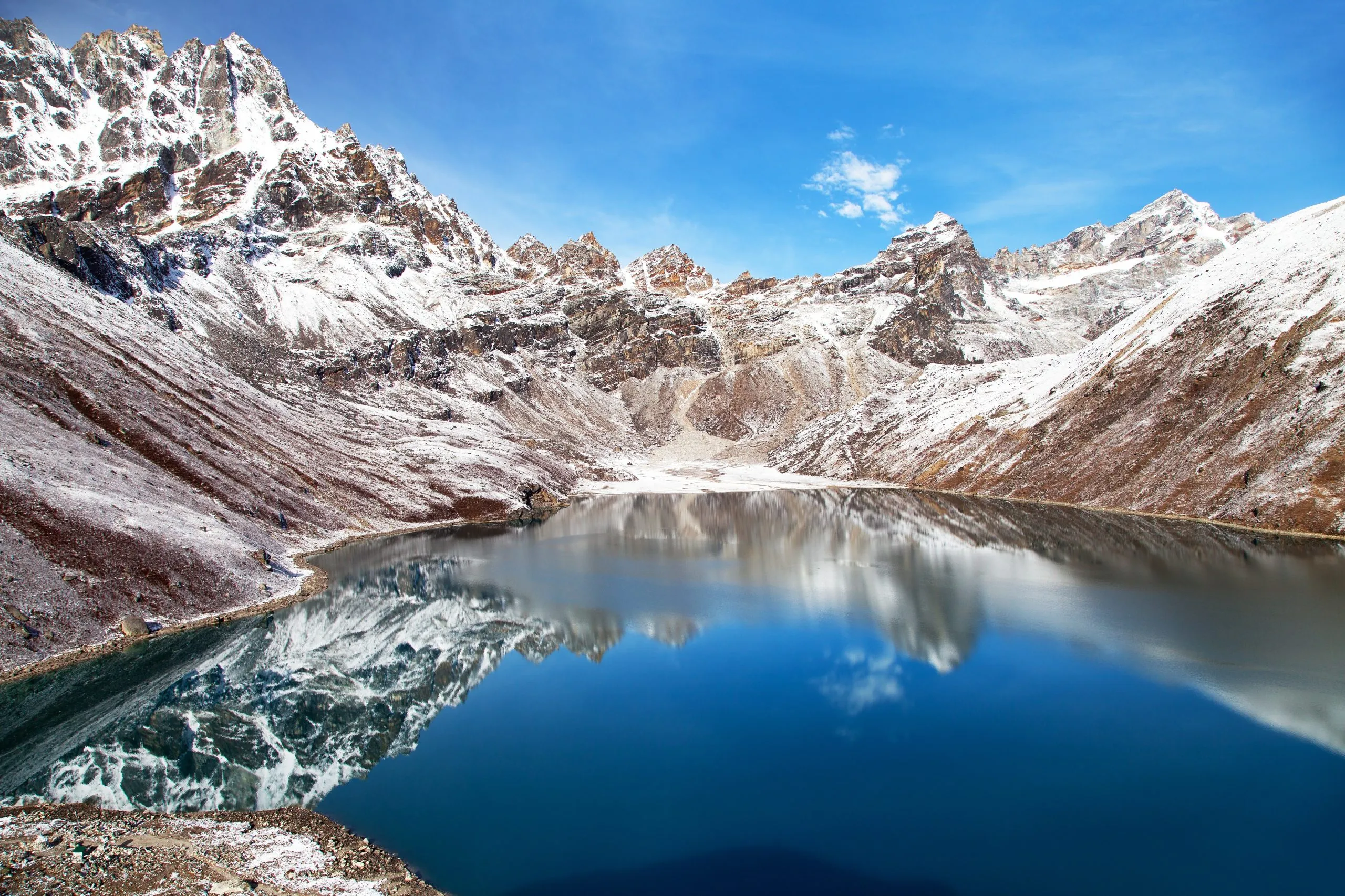Nestled in the majestic Khumbu region of Nepal, this trek encapsulates the ethereal beauty of Gokyo Lake, offering trekkers a once-in-a-lifetime opportunity to explore the Himalayan wilderness.
This guide is crafted to be your essential companion, providing insights, practical advice, and tailored information to ensure a successful and enriching trekking experience.
From understanding the unique cultural heritage to preparing for high-altitude challenges, from selecting the right gear to knowing the best times to visit, this guide equips you with everything needed for an unforgettable adventure in the heart of the Himalayas.
Let the exploration begin, and let this guide illuminate the path to your extraordinary journey.
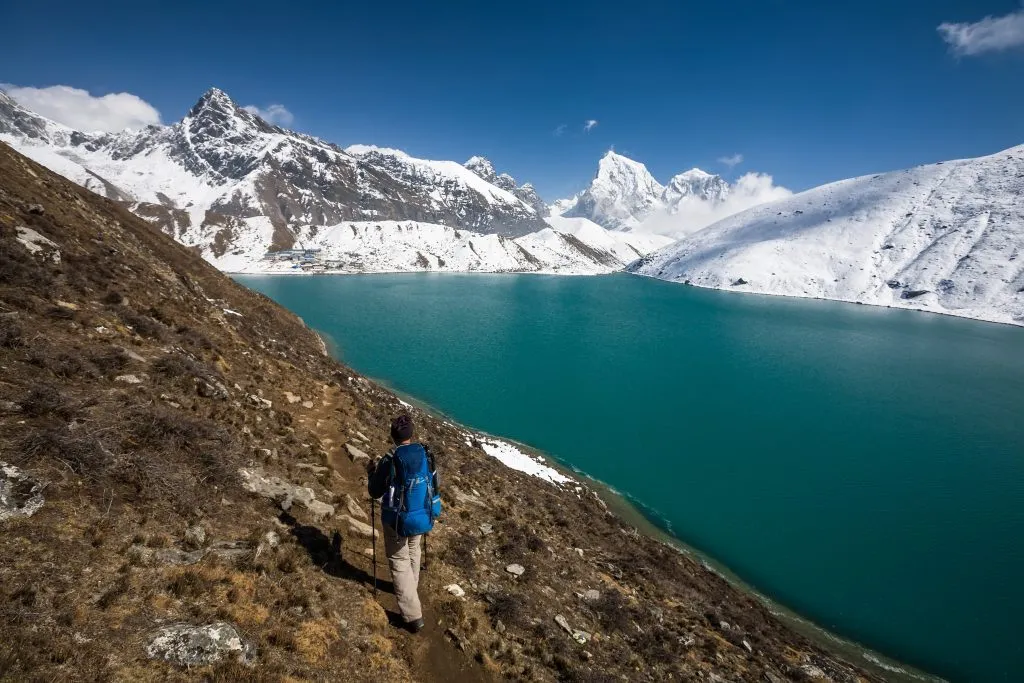
An overview of the trek in numbers
| Total Distance | 92 km (57 miles) |
| Highest Point | 5,357 m (17,575 ft) |
| Fitness Difficulty | 4/5 |
| Technical Difficulty | 2/5 |
| Duration | 10 – 14 days |
What is the Gokyo Lakes Trek?
The Gokyo Lakes Trek is a captivating journey that leads adventurers into the heart of the Khumbu region of Nepal, offering an alternative to the more crowded Everest Base Camp Trek. This trek is renowned for its series of emerald green lakes, set against the backdrop of stunning Himalayan peaks, including Everest, Lhotse, Makalu, and Cho Oyu.
The trek begins with a scenic flight to Lukla, followed by a journey through picturesque Sherpa villages, dense rhododendron forests, and across suspension bridges over the Dudh Koshi River. As trekkers ascend higher, they are rewarded with breathtaking views of the Himalayan range and the opportunity to explore the Gokyo Valley.
Trekkers traverse through dense rhododendron forests, cross turbulent rivers, and hike past terraced fields, all while being surrounded by towering mountain ranges.
The trek also provides a unique opportunity to experience the rich cultural heritage of the local Sherpa communities, explore serene turquoise lakes, and challenge oneself with high mountain passes. The combination of natural beauty and cultural encounters makes this trek an unforgettable adventure in the heart of the Himalayas.
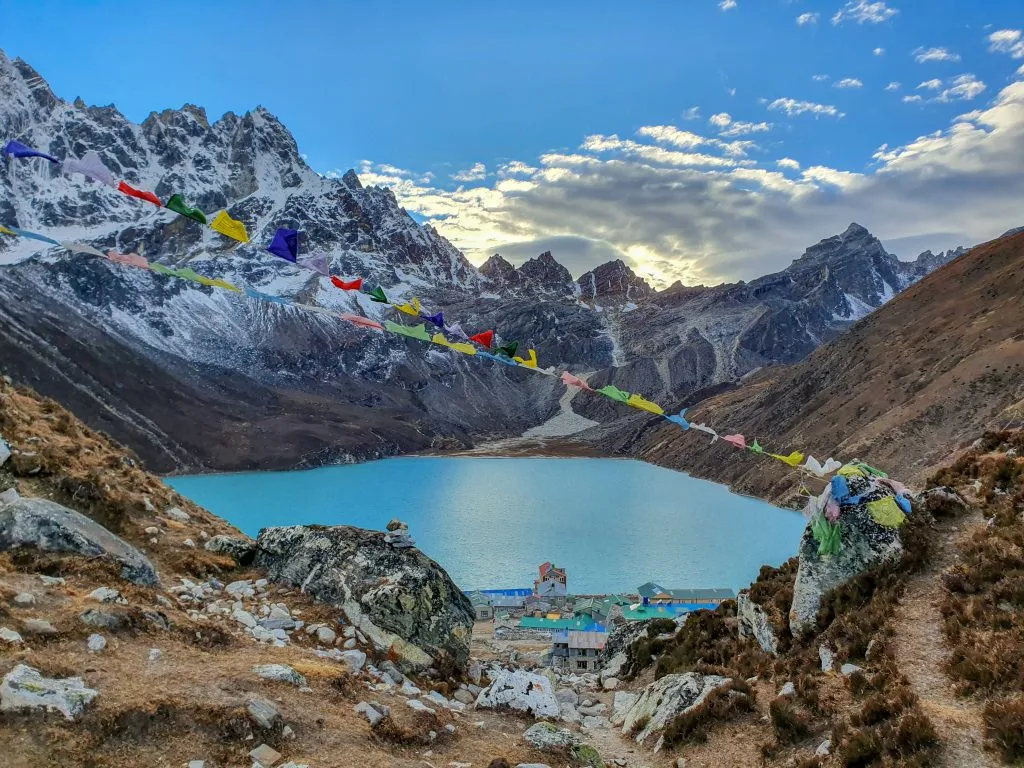
Historical and Cultural Significance
The Gokyo Lakes are a series of six oligotrophic lakes in Nepal’s Sagarmatha National Park, located at an altitude of 4,700–5,000 meters (15,400–16,400 feet). These lakes are the world’s highest freshwater lake system and hold significant religious importance among the Hindu and Buddhist communities.
The Gokyo Lakes are considered sacred by both Hindus and Buddhists. Hindu scriptures describe these lakes as the abode of the snake god, “Nag Devata.” A temple dedicated to Lord Vishnu is located at the western corner of the lake, attracting devotees during the Janai Purnima festival, which usually occurs in August.
The lakes are a significant pilgrimage site, and during the Janai Purnima festival, hundreds of pilgrims visit the area. The festival is marked by ritual bathing and spiritual ceremonies. The local Sherpa community also holds these lakes in high regard, and they are an integral part of their cultural and spiritual identity.
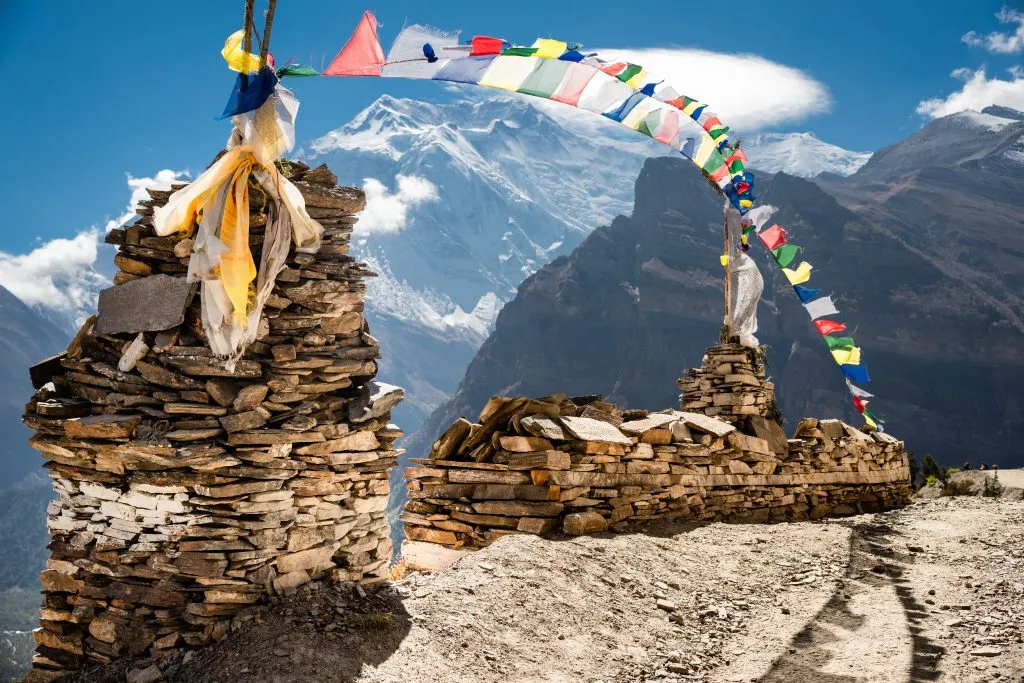
Highlights and Appeal of the Trek
Main highlights of the trek
- Exploration of Gokyo Lakes: Discover the sacred Gokyo Lakes, a series of six glacial lakes at high altitudes.
- Panoramic Views from Gokyo Ri: Ascend Gokyo Ri for an unparalleled panorama of the Everest range and surrounding peaks.
- Crossing the Cho La Pass: Experience the thrill of crossing the challenging Cho La Pass, one of the high mountain passes in the region.
- Sherpa Culture and Hospitality: Immerse yourself in the rich culture and warm hospitality of the Sherpa community.
- Trek through Diverse Landscapes: Traverse through dense forests, alpine meadows, and glacial moraines, witnessing the diverse landscapes of the Khumbu region.
Points of Interest Nearby
- Ngozumpa Glacier: The largest glacier in Nepal, it offers a unique opportunity to witness the grandeur of glacial landscapes.
- Fifth Lake (Thonak Tsho): A viewpoint near Fifth Lake offers a mesmerizing view of the Everest range and the turquoise Gokyo Lakes.
- Sagarmatha National Park: Explore the unique biodiversity of Sagarmatha National Park, home to rare species like the Snow Leopard and Red Panda.
- Kathmandu Durbar Square: A UNESCO World Heritage Site, this square is home to palaces, temples, and courtyards that showcase the rich history and architecture of Nepal.
- Swayambhunath (Monkey Temple): This ancient religious complex is known for its iconic stupa and the monkeys that inhabit the area.
- Boudhanath Stupa: One of the largest spherical stupas in Nepal, Boudhanath is a center of Tibetan Buddhism and a place of meditation and pilgrimage.
- Pashupatinath Temple: A significant Hindu temple dedicated to Lord Shiva, located on the banks of the Bagmati River.
- Bhaktapur Durbar Square: Another UNESCO World Heritage Site, Bhaktapur offers a glimpse into medieval Nepal with its preserved ancient buildings and cultural heritage.
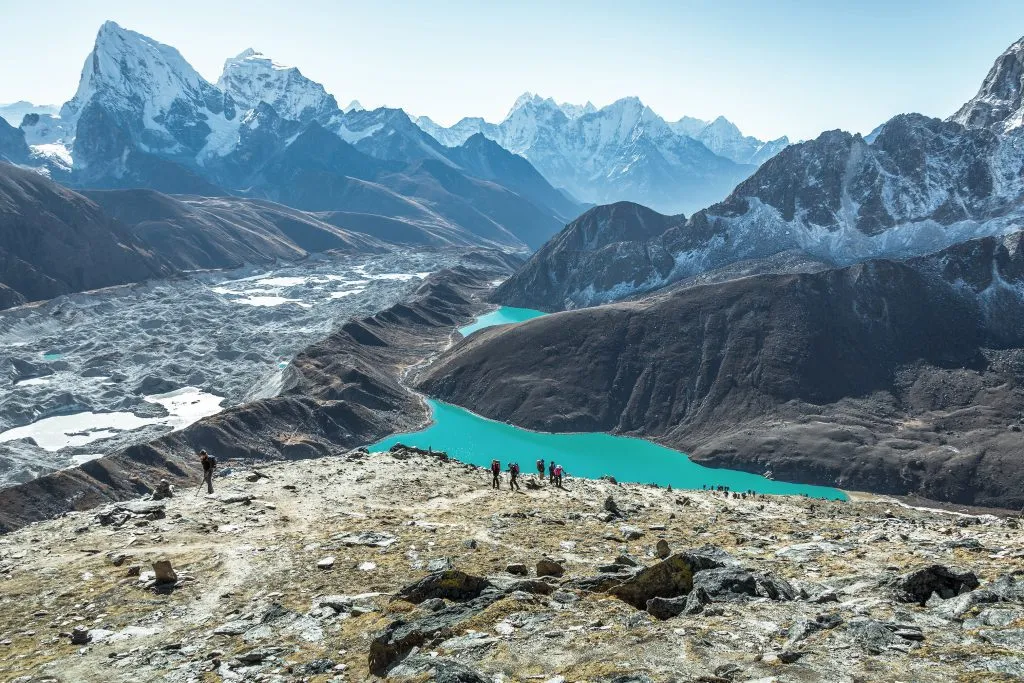
Trekking the Gokyo Lakes Trek
When to go on the trek?
The Gokyo Lakes Trek offers an incredible experience, but timing your trek right can make it even more memorable.
The best time to embark on this trek is during the pre-monsoon months of March to May or the post-monsoon months of September to November. During these periods, the weather is usually stable and dry, providing excellent trekking and sightseeing conditions.
In the pre-monsoon season, the mountains are lush and green, while September to November is considered the optimal time to trek, offering clear skies and pleasant temperatures. Unlike the classic Everest Base Camp Trek, the Gokyo Lakes variation is less crowded, so trekking during the peak season should not be an issue. It’s advisable to avoid the peak of summer when the monsoon season is at its zenith, as the heavy rains can make the trails challenging and less enjoyable.
By choosing the right time, you can enjoy the breathtaking landscapes and cultural experiences that this trek has to offer without the hindrance of unfavorable weather conditions.
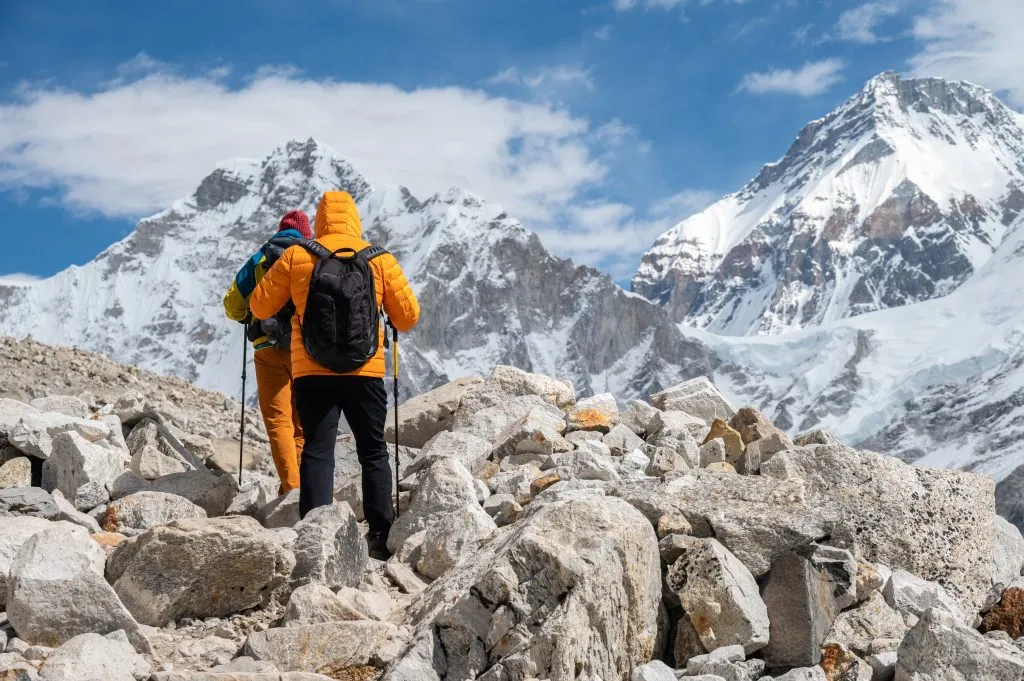
How to get there?
Getting to the starting point of the Gokyo Lakes Trek involves international and domestic flights. Here’s a detailed guide to the transportation options:
Kathmandu’s Tribhuvan International Airport is well-connected with various international airlines operating flights to Nepal. Some of the major airlines include Malaysian Air, Qatar Airways, Fly Dubai, Air Arabia, Turkish Airlines, Thai Lion Air, and Nepal’s national flight, Nepal Airlines (RA). Additionally, Indian airlines such as Air India and Vista Air offer connections from Delhi. Travelers can find convenient connections through major hubs like Bangkok, Dubai, and Malaysia.
Once in Kathmandu, the next step is to take a domestic flight to Lukla, the gateway to the Everest region. This flight is a thrilling experience in itself, offering breathtaking views of the Himalayan peaks and landing at one of the world’s most challenging airports. Booking in advance is recommended, especially during peak trekking seasons.
After completing the trek, you’ll return to Lukla for a flight back to Kathmandu. It’s wise to have some flexibility in your schedule, as weather conditions in the mountains can sometimes cause delays.
By planning your transportation carefully and considering the available options, you can ensure a smooth and convenient journey to and from the Gokyo Lakes Trek.
Whether arriving from international destinations or navigating domestic connections, understanding the transportation logistics is essential for a successful trekking experience.
Accommodation
Accommodation along the Gokyo Lakes Trek varies, reflecting the remote and rugged nature of the region. Here’s what you can expect:
In Kathmandu, you’ll find a wide range of accommodation options, from budget-friendly guesthouses to luxurious hotels. Many trekkers choose to stay in the popular tourist area of Thamel, where numerous lodging options cater to different preferences and budgets.
From Lukla to Namche Bazaar, the trail offers several teahouses and lodges. These establishments provide basic amenities, including beds, blankets, and meals. While the facilities are simple, they are generally clean and comfortable.
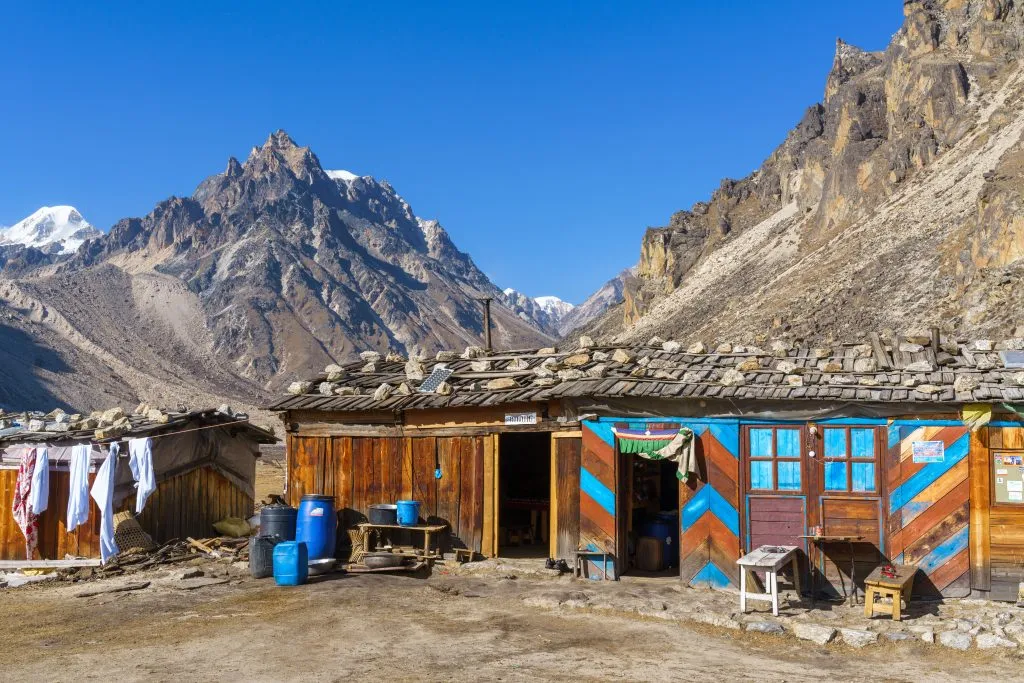
As you ascend to higher altitudes (Gokyo Valley), the accommodation becomes more basic. Teahouses in the Gokyo Valley offer essential facilities, and some may have shared bathrooms. Heating may be limited, and it’s advisable to carry a good-quality sleeping bag for added warmth.
The accommodation experience along the Gokyo Lakes adds to the authentic mountain experience, allowing trekkers to immerse themselves in the local culture and hospitality.
Food
Most teahouses offer a menu with a variety of local and international dishes. Typical Nepali food like Dal Bhat (rice, lentils, and vegetables) is widely available, along with pasta, pancakes, and other familiar items. It’s wise to stick to freshly cooked meals and avoid raw vegetables to minimize the risk of stomach issues.
- Local Cuisine: The staple food is “Dal Bhat,” a traditional Nepali meal consisting of rice, lentil soup, vegetables, and pickles. It’s nutritious and often served in unlimited quantities.
- International Options: Many teahouses offer a variety of international dishes like pasta, pizza, pancakes, and more.
- Beverages: Tea, coffee, and soft drinks are widely available. Some places may offer local alcoholic beverages.
- Snacks: It’s advisable to carry some snacks like energy bars or dry fruits, as buying them on the trail can be expensive.
The food is freshly prepared, and vegetarian options are usually available. As you ascend higher, the menu may become more limited, and prices may increase due to the remote location.
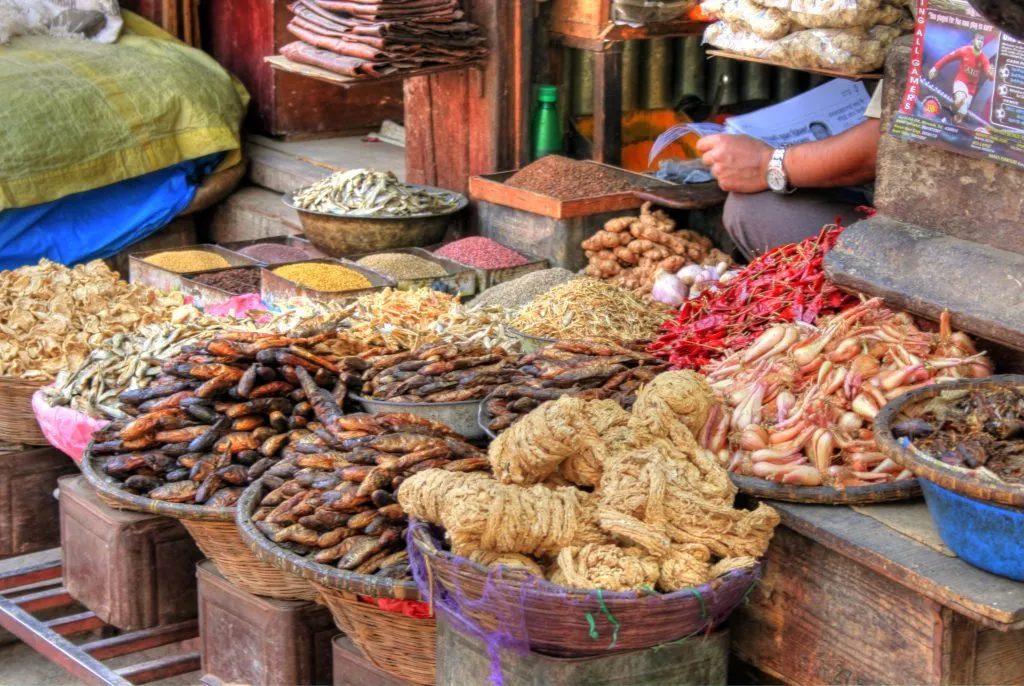
Gokyo Lakes Trek Itinerary
The Gokyo Lakes Trek is a captivating journey through the Everest region, leading trekkers to the world’s highest freshwater lake system. This itinerary provides a brief overview of the classic Gokyo Lakes Trek, outlining the day-to-day journey and altitudes. Additionally, we provide variations to the trek for those who wish to explore the surroundings.
The Classic Gokyo Lakes Trek Itinerary
The Classic Gokyo Lakes Trek is a journey that takes you through the heart of the Khumbu region. Starting from Lukla, the trek passes through picturesque villages, lush forests, and offers breathtaking views of the Himalayan peaks. The highlight of the trek is the ascent to Gokyo Ri, providing panoramic views of the Gokyo Lakes and surrounding mountains. This trek is perfect for those looking to explore the serene beauty of the Gokyo Valley without the added challenge of reaching Everest Base Camp.
- Day 1: Lukla to Phakding (2700 meters / 8858 feet)
- Day 2: Phakding to Namche (3440 meters / 11286 feet)
- Day 3: Namche Bazaar (Acclimatization) (3440 meters / 11286 feet)
- Day 4: Namche to Kenjoma (3600 meters / 11811 feet)
- Day 5: Kenjoma to Mong La (3900 meters / 12800 feet)
- Day 6: Mong to Dole (4090 meters / 13419 feet)
- Day 7: Dole to Machermo (4410 meters / 14469 feet)
- Day 8: Machermo to Gokyo (4750 meters / 15584 feet)
- Day 9: Gokyo Ri (5357 meters / 17575 feet)
- Day 10: Gokyo – Dole (4090 meters / 13419 feet)
- Day 11: Dole – Namche (3440 meters / 11286 feet)
- Day 12: Namche – Phakding (2700 meters / 8858 feet)
- Day 13: Phakding – Lukla (2860 meters / 9383 feet)
Gokyo Lake to Everest Base Camp Trek
Combining the beauty of the Gokyo Lakes with the thrill of reaching Everest Base Camp, this trek offers the best of both worlds. After exploring the Gokyo Valley and ascending Gokyo Ri, the trail joins the main Everest Base Camp route at Lobuche. The trek continues to Everest Base Camp and Kala Patthar, offering unparalleled views of Mount Everest. This challenging and rewarding trek typically takes 17-20 days and is suited for experienced trekkers.
Explore the detailed itinerary of the Gokyo Lake to Everest Base Camp Trek and embark on the adventure of a lifetime with our expert team.
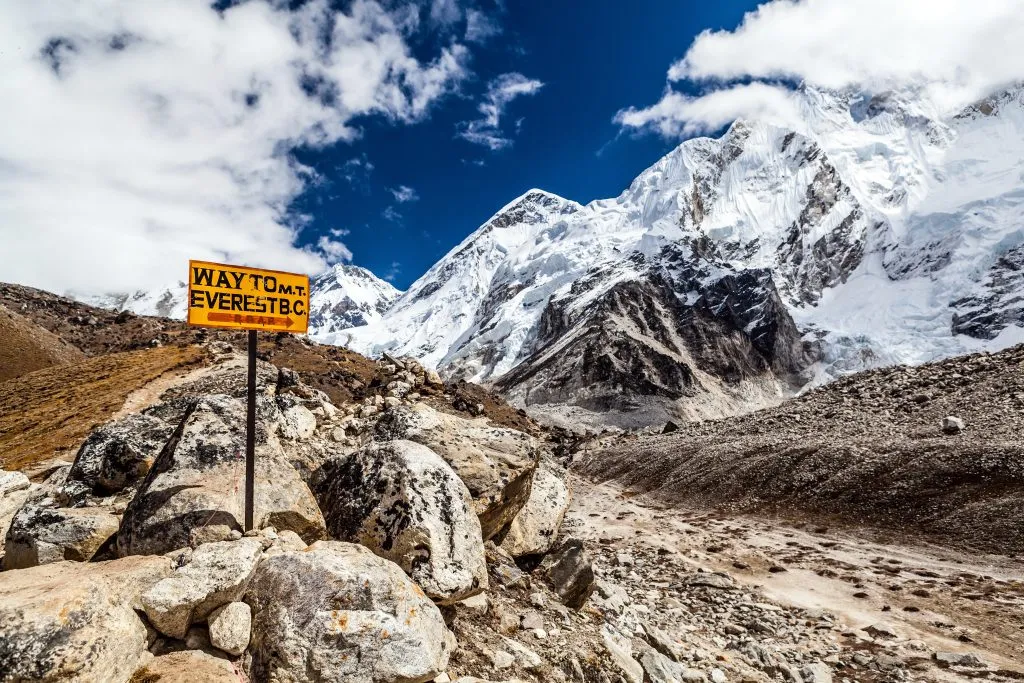
Gokyo Lakes with Renjo La Pass
This variation adds an exciting challenge by including the crossing of the Renjo La Pass (5360 meters / 17585 feet). The trek follows the classic route up to Gokyo and then heads over the pass to Thame, adding 2-3 days to the itinerary. The Renjo La Pass offers stunning views of Everest and other nearby peaks. This option is suitable for trekkers looking for a bit more adventure and a unique perspective of the Everest region.
- Day 1: Arrival in Kathmandu (1,400 meters / 4,593 feet)
- Day 2: Lukla to Phakding (2,600 meters / 8,530 feet)
- Day 3: Phakding to Namche Bazaar (3,440 meters / 11,286 feet)
- Day 4: Namche Bazaar (Acclimatization)
- Day 5: Namche to Thame (3,820 meters / 12,533 feet)
- Day 6: Thame to Lungden (4,380 meters / 14,370 feet)
- Day 7: Lungden to Gokyo via Renjo La Pass (5,360 meters / 17,585 feet)
- Day 8: Gokyo Lakes and Gokyo Ri (5,357 meters / 17,575 feet)
- Day 9: Gokyo to Dole (4,090 meters / 13,415 feet)
- Day 10: Dole to Namche Bazaar
- Day 11: Namche to Lukla
Required Permits and Visas
Visa
All foreigners require a visa to enter Nepal. Visas are available on arrival at Kathmandu airport or any other entry point into Nepal. To obtain a visa, you must have a passport valid for at least six months. For more visa details, visit Nepali Immigration Portal.
On-Arrival Visa Fee:
- 15 Days – 30 USD
- 30 Days – 50 USD
- 90 Days – 125 USD
Permits
For the Gokyo Lakes Trek, trekkers must obtain the following permits:
- Sagarmatha National Park Entry Permit: This permit is required to enter the Sagarmatha National Park, where Mount Everest and the surrounding areas are located. The fee is NPR 3000 (approx. 23 USD) for each foreigner and NPR 1500 (approx. 11.5 USD) for every Indian traveler.
- Khumbu Pasang Lhamu Rural Municipality Entrance Permit: This local permit replaces the previously required TIMS card for the Everest region. It can be obtained in Lukla and costs NPR 2,000 (approx. USD 18).
The required permits for the Gokyo Lakes Trek can be obtained at different locations. The Sagarmatha National Park Entry Permit is available at the Nepal Tourism Board Office in Kathmandu or at the Monjo park entrance gate, while the Khumbu Pasang Lhamu Rural Municipality Entrance Permit can be acquired in Lukla.
When applying for these permits, you must present specific documents such as your insurance policy number, details of your daily itinerary and route, a copy of your passport, and two passport-sized photos.
If you’ve entrusted your trek planning to a local agency, they will typically handle the permit arrangements for you. However, it’s wise to verify the latest information on relevant websites, as regulations and requirements may change.
Please note that these permits are non-transferable and non-refundable. Children under the age of 10 are exempt from the entry fees. It’s crucial to keep these permits with you throughout the trek, as you’ll be required to present them at various checkpoints.
Challenges of the Gokyo Lakes Trek
The Gokyo Lakes Trek is an awe-inspiring journey that leads you through the remote sections of the Khumbu region, offering breathtaking views of greenish-blue Gokyo Lakes and numerous snow-capped peaks. However, this trek is not without its challenges, and understanding them is key to a successful and enjoyable experience.

Altitude and Altitude Sickness
The trek reaches elevations as high as Gokyo Ri at 5,357 meters (17,575 ft) above sea level. The reduced air pressure and low oxygen content at these altitudes can lead to altitude sickness. Symptoms may include headaches, nausea, and dizziness. Proper acclimatization, maintaining a steady pace, staying hydrated, and avoiding alcohol can help prevent this condition.
Trek Duration and Distance
The Gokyo Lakes Trek can vary in duration and distance, with popular options ranging around 12 days. Walking 5 to 6 hours a day and covering 10 km on average can be challenging, especially for those without prior experience. Adequate rest and acclimatization days are essential to cope with exhaustion and altitude sickness.
Weather and Temperature
Starting from Lukla’s moderate warmth, the temperature drops significantly as you ascend, with the possibility of frostbite at higher elevations. Proper cold-blocking clothing and preparation for icy winds are vital to maintaining comfort.
Heavy Luggage
Carrying heavy luggage on long, rugged, and steep trails can be a major challenge. Overloading with unnecessary items can lead to fatigue and distraction. Hiring a porter or carefully packing only essential items can alleviate this difficulty.
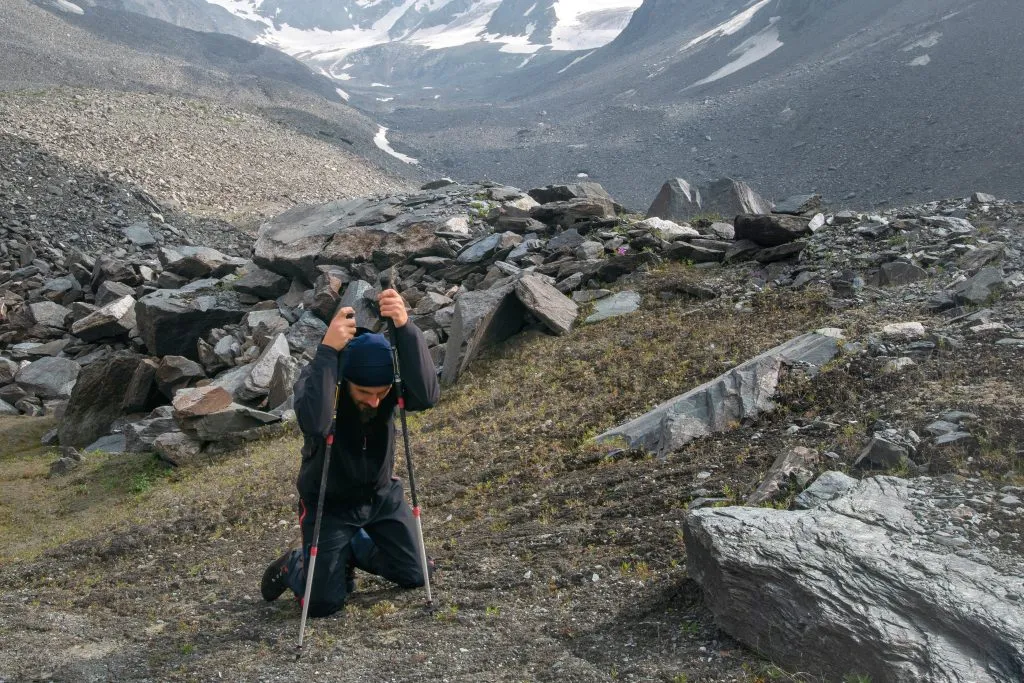
Guided vs. Non-Guided Trek Options
Embarking on the Gokyo Lakes Trek presents two distinct options: guided or non-guided treks, with the additional possibility of hiring porters.
Guided treks offer the advantage of expert navigation, safety protocols, and a deeper understanding of the local culture and environment. Guides are trained to handle emergencies, secure accommodations, and provide insights into the best routes and viewpoints. Additionally, many guided treks include the services of porters, who assist in carrying equipment and supplies, further easing the physical demands of the trek.
On the other hand, a non-guided trek offers a sense of independence and adventure for experienced trekkers familiar with the region. However, it comes with increased risks and responsibilities, including managing one’s accommodations, understanding the terrain, and being prepared for emergencies. Even in a non-guided trek, hiring a local porter can be a valuable option, providing support without the full guidance of a trek leader.
In light of recent advisories from the Nepalese Tourism Board and considering the unique challenges of the Gokyo Lakes region, opting for a guided trek with a reputable company is often the preferred choice. It aligns with safety recommendations and enriches the overall experience, allowing trekkers to fully immerse themselves in the beauty and culture of the region without unnecessary concerns.
The inclusion of porter services, whether in a guided or non-guided trek, adds an extra layer of convenience and support, making the journey more enjoyable and accessible.

Cost of hiking the Gokyo Lakes trek
The cost of hiking the Gokyo Lakes Trek can vary widely depending on several factors, including the choice between a guided or non-guided trek, the level of accommodation, the inclusion of porter services, and the time of year. On average, the Gokyo Lake Trek cost may range from $1,200 to $1,800 per person for a typical 12-day trek.
Guided treks often include services such as airport transfers, accommodations, meals during the trek, permits, and the expertise of a professional guide, and possibly porters. These comprehensive packages provide convenience but tend to be at the higher end of the cost spectrum.
For those opting for a non-guided trek, expenses can be managed more individually, allowing for potential cost savings. However, trekkers must budget for permits, food, accommodations, transportation, and any hired porter services separately.
Additional costs to consider include travel insurance, personal gear and equipment, tips for guides and porters if applicable, and any extra activities or side trips. It’s advisable to consult with trekking companies or experienced trekkers to get a detailed breakdown of costs and to plan according to personal preferences and needs.
How to prepare for the trek
Physical preparation
The Gokyo Lakes Trek is a challenging adventure that demands a good level of physical fitness and preparation. The trek involves long days of walking, often over rough terrains and steep ascents, reaching altitudes above 5,000 meters (16,400 feet). Therefore, physical preparation is essential to enjoy the trek and minimize the risk of injuries or health issues.
A well-rounded training program that includes cardiovascular exercises, strength training, and endurance building is highly recommended. Activities such as running, cycling, swimming, and hiking can help build stamina and cardiovascular fitness. Strength training focusing on leg muscles, core, and upper body will enhance stability and carrying capacity, especially if you plan to carry your backpack.
Additionally, practicing hikes with varied terrains and elevations, preferably with a loaded backpack, can provide valuable experience and condition the body for the demands of the trek. Flexibility exercises and stretching are also beneficial to prevent muscle strains.

Packing and gear
One of the key aspects of this preparation is ensuring that you have all the necessary equipment and personal items to make your trek comfortable, safe, and enjoyable. From essential hiking gear to personal care products, the right packing can make a significant difference in your overall experience.
The following packing list is designed to guide you through the selection of items that are vital for this specific trek.
Hiking Gear
- Hiking boots
- Walking poles
- Day bag
- Water bottle
- Headlight
Clothing and Body Wear
- Down jacket
- Windproof jacket
- Fleece jacket and pants
- Light warm hiking trousers
- Long and half-sleeve hiking shirts
- Warm liner
- Warm hiking socks (wool/synthetic)
- Warm and sun hats
- Gloves/mittens
- Buff (for neck and head)
- Flip flops/Sandals
Sleeping and Personal Care
- Sleeping bag
- Towel
- Sun cream
- Sunglasses
- Sun hat
- Lip-guard
- Toothbrush
- Face wash soap
- Sanitizer
- Prescription medicine
- Water purifier tablets/lightweight filter
- Toilet paper
- Menstrual products
Personal Belonging Items
- Passport
- Cash
- Visa/credit card
- Cell phone with power bank backup and charger
- Camera/GoPro
This list is comprehensive and covers the essentials for the Gokyo Lakes Trek. Make sure to consult with your trekking guide or company for any specific requirements or recommendations tailored to your particular trek.

Final Insights for a Memorable Gokyo Lakes Trek Experience
Gokyo Lakes Trek is an adventure filled with breathtaking views and rich cultural experiences. To make the most of this journey, consider the following insights:
Choose the right season, such as spring or autumn, for stable weather and clear skies. Stay hydrated and eat well-balanced meals to maintain energy levels. Show respect for the local Sherpa culture by following their customs and traditions, and be environmentally responsible by minimizing waste.
Travel insurance that covers high-altitude trekking and emergencies is essential. If you have a guide, heed their advice, and pace yourself to allow for proper acclimatization. Be prepared for unexpected weather changes by packing appropriate clothing, and keeping essential documents handy.
Stay connected with local SIM cards or portable chargers, but most importantly, enjoy the journey. The Gokyo Lakes Trek is not just about reaching the destination; it’s about embracing the entire experience. By following these tips, you’ll be well-prepared for an unforgettable trek.
Why join an organized expedition?
While some may opt to explore independently, joining an organized expedition offers distinct advantages that can significantly enhance the overall experience.
An organized expedition provides expert guidance from professional guides who know the region’s geography, weather, and potential hazards. Their expertise ensures safe navigation and enriches the journey with cultural insights and local interactions. The logistical support offered by organized treks takes the burden of planning off the trekkers, handling everything from transportation and accommodation to permits and meals.
Safety is a paramount concern, and organized expeditions come with trained guides equipped to handle emergencies and unexpected situations. Many also adhere to sustainable practices that align with responsible trekking principles. The opportunity to choose from customized packages allows trekkers to find an option that fits their needs, interests, and budgets.
Joining an organized expedition for the Gokyo Lakes Trek offers a well-rounded and enriching experience. It allows trekkers to fully immerse themselves in the adventure without the stress of planning and uncertainty.
Explore our detailed program for the Gokyo Lakes to Everest Base Camp Trek and take the first step towards an unforgettable adventure in the heart of the Himalayas.
